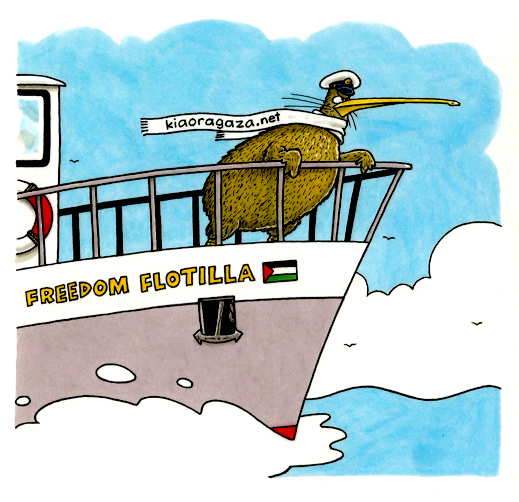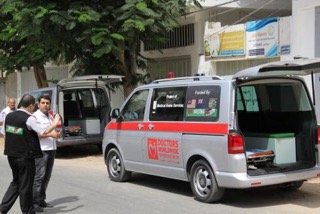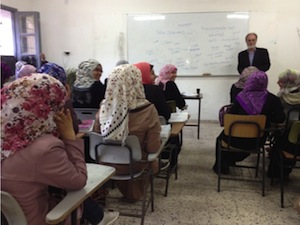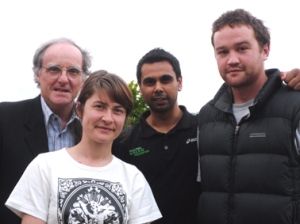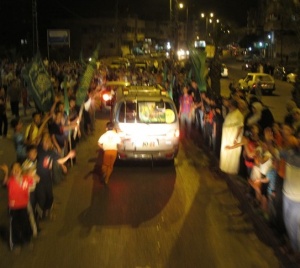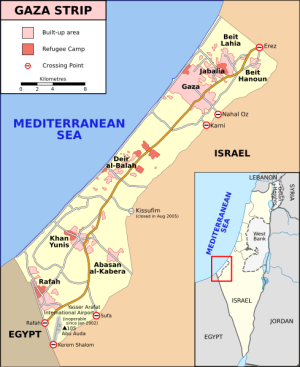 The Israeli siege on Gaza has devastated Gaza’s economy and led to what the UN has called the ‘de-development’ of the territory [EPA]
The Israeli siege on Gaza has devastated Gaza’s economy and led to what the UN has called the ‘de-development’ of the territory [EPA]
Al Jazeera, 27 June 2017
A guide to the Gaza Strip
From Israel’s occupation to a decade of siege, here is all you need to know about ‘the world’s largest open-air prison’.
The Israeli siege on Gaza has devastated Gaza’s economy and led to what the UN has called the ‘de-development’ of the territory [EPA]
The Gaza Strip, home to two million Palestinians, is frequently on the news. The small enclave is one of the most densely populated areas in the world and has been aptly described as “the world’s largest open-air prison”.
It is a small self-governing Palestinian territory that came under Israeli occupation, along with the West Bank and East Jerusalem, after the 1967 Arab-Israeli War.
Bordered by Israel and Egypt on the Mediterranean coast, the strip is about the size of the US city of Detroit – about 360sq km.
Gaza was part of historic Palestine before the state of Israel was created in 1948 in a violent process of ethnic cleansing, expelling hundreds of thousands of Palestinians from their homes.
It was captured by Egypt during the 1948 Arab-Israeli War and remained under Egyptian control until 1967, when Israel seized the remaining Palestinian territories in a war with the neighbouring Arab countries.
Gaza is but one of the focal points in the Israeli-Palestinian conflict. Although it is part of the Israeli-occupied territories, the Gaza Strip was severed from the West Bank and East Jerusalem when Israel was created. A range of Israeli restrictions have since been created that further compartmentalise the Palestinian territories.
Siege
The Israeli blockade of the occupied Gaza Strip, in its current form, has been in place since June 2007, when Israel imposed an airtight land, sea and air blockade on the area.
Israel controls Gaza’s airspace and territorial waters, as well as two of the three border crossing points; the third is controlled by Egypt
Israel allows passage through the Beit Hanoun crossing only in “exceptional humanitarian cases, with an emphasis on urgent medical cases”.
According to a 2016 United Nations report, the Rafah crossing had been continuously closed since October 2014, including for humanitarian assistance, except for 72 days of partial openings.
According to the same report, one-third of exit permit applications for medical treatment outside of Gaza submitted in 2016 were rejected or delayed by Israel.
But Israel has restricted the movement of Palestinians in and out of Gaza for much longer than the past 10 years. Starting in the late 1980s with the eruption of the first Palestinian uprising, or Intifada, Israel began to impose restrictions by introducing a permit system that required Palestinians in Gaza to get difficult-to- obtain permits to work or travel through Israel or access the occupied West Bank and East Jerusalem.
Since 1993 in particular, Israel has used “closure” tactics on the Palestinian territories on a regular basis, at times barring any and all Palestinians in certain areas from leaving, sometimes for months at a time.
In 1995, Israel built an electronic fence and concrete wall around the Gaza Strip, facilitating a collapse in interactions between the split Palestinian territories.
In 2000, when the Second Intifada erupted, Israel cancelled many of the existing travel and work permits in Gaza, and significantly reduced the number of new permits issued.
READ MORE: Gaza – a life under occupation
In 2001, Israel bombed and demolished the Gaza airport, only three years after it opened.
Four years later, in what Israel called the “disengagement” from Gaza, some 8,000 Jewish Israelis living in illegal settlements in Gaza were pulled out from the Strip.
Israel claims that its occupation of Gaza ceased since it pulled its troops and settlers from the territory, but international law views Gaza as occupied territory since Israel has full control over the space.
In 2006, the Islamic Resistance Movement, Hamas, won general elections and seized power in a violent conflict with its rival, Fatah, after the latter refused to recognise the outcome of the vote. Since Hamas’ rise to power in 2007, Israel has severely intensified its siege.
A woman waits for a travel permit to cross into Egypt through the Rafah border crossing after it was opened for four days by Egyptian authorities, in the southern Gaza Strip June 1, 2016 [Reuters]
Israel’s blockade has cut off Palestinians from their main urban centre, Jerusalem, which hosts specialised hospitals, foreign consulates, banks and other vital services, even though the terms of the 1993 Oslo Accords stated that Israel must treat the Palestinian territories as one political entity, not to be divided.
By blocking travel to East Jerusalem, Israel is also cutting off Christian and Muslim Palestinians in Gaza from accessing their centres of religious life.
Families have been ripped apart, youth have been denied the opportunity to study and work outside of Gaza, and many have been denied their right to obtain necessary healthcare.
The blockade contravenes Article 33 of the Fourth Geneva Convention, which prohibits collective punishment and prevents the realisation of a broad range of human rights.
Humanitarian situation
Israel’s siege on Gaza has devastated its economy and led to what the UN has called the “de-development” of the territory, a process by which development is not merely hindered but reversed.
About 42 percent of Palestinians in Gaza suffer from poverty, youth unemployment stands at 58 percent, and some 80 percent rely on international aid, mainly food supply, according to the World Bank.
“Even more shocking is the reality that most of Gaza’s 1.8 million residents are confined to an area of 160sq km and are not able to travel beyond this area without permits,” Steen Lau Jorgensen, World Bank country director for West Bank and Gaza, said in a 2015 report.
More than 60 percent of Palestinians in Gaza are refugees, expelled from their homes in other parts of Palestine in 1948, in places such as Lod and Ramle, and now live just a few kilometres away from their original homes and towns.
A Palestinian woman and her child look out of the window of their shelter in Deir al-Balah refugee camp in the central Gaza Strip, July 29, 2016 [Reuters]
The siege has led to shortages of basic items, like food and fuel. It has also stymied Gaza’s potential for long-term economic development. Chronic problems, such as access to education, healthcare and clean water, have become more pronounced.
Since the beginning of the siege, Israel has launched three protracted military assaults on Gaza: in 2008, 2012 and 2014. Each of these attacks has exacerbated Gaza’s already dire situation. Tens of thousands of homes, schools and office buildings have been destroyed.
Rebuilding has been next to impossible because the siege prevents construction materials, such as steel and cement, from reaching Gaza.
Over the years, Israeli missile attacks and ground incursions have also damaged Gaza’s pipelines and sewage treatment infrastructure. As a result, sewage often seeps into drinking water, which has resulted in a sharp increase in waterborne disease.
More than 90 percent of Gaza’s water has been rendered unsafe for drinking.
Plans to improve Gaza’s water quality have been thwarted by the ongoing power crisis. Water projects are among the largest consumers of electricity. Without enough power to maintain existing water and sanitation systems, it is impossible to build new ones.
Many homes in Gaza rely on electric pumps to push water to the top of the building. No electricity for them means no water.
Power cuts have had a devastating effect on Gaza’s students. At home, they are forced to study by gas lamp or candlelight. This hinders their ability to concentrate and learn. Generators can power lights, but are loud and often lack enough fuel to power them. At school, blackouts mean food rots, latrines are left dirty, and there is no clean water for washing hands.
One of the most vulnerable groups affected by the siege are those with chronic illnesses. In 2016, Israel approved fewer than 50 percent of requests to exit the Gaza Strip through the Beit Hanoun crossing for medical treatment abroad.
Israel’s blockade has set the stage for a profound humanitarian catastrophe. The UN recently warned conditions are deteriorating at such a rapid pace that, if the current situation continues, Gaza could be uninhabitable by the year 2020.
Hamas rule
Founded in 1987, Hamas emerged during the First Intifada that saw a popular mobilisation of Palestinians against the Israeli occupation.
On January 25, 2006, Hamas defeated Mahmoud Abbas’ long-dominant Fatah party in parliamentary elections. Hamas then kicked Fatah out of the Strip after the latter refused to recognise the vote’s results. Since 2007, Hamas and Fatah have ruled the Gaza Strip and the West Bank respectively.
Fatah, the ruling party in the West Bank, is led by President of the Palestinian Authority Mahmoud Abbas, who was elected in 2005.
Hamas defines itself as a Palestinian Islamic national liberation and resistance movement, aiming to “liberate Palestine and confront the Zionist project”.
READ MORE: UN warns of Gaza’s ‘total collapse’ amid power crisis
While Hamas’ 1988 founding charter called for the liberation of all of historic Palestine, including present-day Israel, it recently released a new political document, in which the movement stated it would accept the 1967 borders as the basis for a Palestinian state, with Jerusalem as its capital and the return of refugees to their homes.
Hamas does not recognise the state of Israel’s legitimacy and has chosen armed resistance as its method for the liberation of the territories.
Israeli assaults on Gaza
After laying siege on Gaza in 2007, Israel launched three major, sustained assaults on the area between 2008 and 2014.
The assaults destroyed much of the city’s infrastructure, including Gaza’s sole power plant. The Strip has been experiencing an electricity crisis for a decade, with most homes, businesses, and hospitals receiving power intermittently – at times, only up to three hours a day.
Fuel needed to generate power, food, and water shortages are also a constant reality for residents of the Strip. Tens of thousands of people in Gaza, including refugees, live in tents. Israel bans the entry of vital building material, such as steel and cement, and other construction goods.
In 2008, after Hamas pushed out Fatah, the first major Israeli assault on Gaza continued for 23 days. Referred to by Israel as “Operation Cast Lead”, 47,000 homes were destroyed and more than 1,440 Palestinians were killed, including at least 920 civilians.
In 2012, Israeli forces killed 167 Palestinians, including 87 civilians, in an eight-day assault dubbed “Operation Pillar of Defense” by Israel. The death toll included 35 children and 14 women.
Gaza’s infrastructure was also heavily damaged; 126 houses were completely destroyed, and schools, mosques, cemeteries, health and sports centres, and media institutions were also hit, among other structures.
Two years later, in 2014, over a span of 50 days, Israel killed more than 2,100 Palestinians, including 1,462 civilians and close to 500 children.
During the assault, dubbed by the Israelis as “Operation Protective Edge”, about 11,000 Palestinians were wounded, 20,000 homes were destroyed and half a million displaced from their homes.
Palestinian schoolgirls walk past the remains of a residential building, destroyed during 2014 war in the northern Gaza Strip on February 10, 2016 [Reuters]
Source: Al Jazeera







